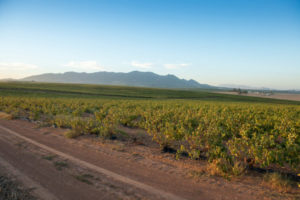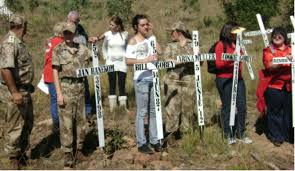Ilana Mercer, American Renaissance, May 1, 2017
The minority that dare not speak its name is on the wane.


March 5, 2015 – Stellenbosch, Western Cape, South Africa – Stellenbosch, South Africa – South African farm land and vineyards (Credit Image: © Edwin Remsberg/VW Pics via ZUMA Wire)
Farm land and vineyards in Stellenbosch, Western Cape, South Africa (Credit Image: © Edwin Remsberg/VW Pics via ZUMA Wire)
Farming in South Africa is the most dangerous occupation in the world. Farmers there suffer more murders per-capita than any other community on earth outside a war zone. Since the dawn of democracy in the country, farming South Africa has been slaughtered by black South Africans in ways that would do Shaka Zulu proud.
The Transvaal Agricultural Union’s numbers (purported to be the most reliable) are bolstered by Genocide Watch. (I wrote about this here.) By this assessment, South African farmers were being exterminated at the annual rate of 313 per 100,000 inhabitants, 3,000 since the election of the sainted Nelson Mandela (1994), two a week, seven in March of 2010, “four times as high as is for the rest of the [South African] population,” in the words of Genocide Watch’s Dr. Gregory H. Stanton.
The number of farmers martyred on land many their families had farmed since the 1600s has since been revised downward by the African National Congress (ANC) government, its police and lickspittle social scientists. This is good if true; bad if doctored for the purpose of diminishing the facts.
The Democratic Alliance used to dispute any crime statistics issued by the South African Police Service (SAPS). The tiny, tokenistic, opposition to the “all-powerful black majority party” puts the ostensible drop in crime down to the fact that 51 percent of victims no longer bother to report crime, given that corruption is rife, arrests rare, and prosecutions and convictions still rarer. Findings suggest that the SAPS’s optimistic, homicide statistics are not to be believed. According to the Economist (citations in Into the Cannibal’s Pot), the Center for the Study of Violence and Reconciliation has confirmed the existence of a “pervasive pattern of (police) manipulation of statistic.”
Every year, millions in taxpayers’ money are forked out to private security firms to protect … the new South Africa’s police stations. “South Africa’s protectors can’t protect themselves,” they can’t protect the country, and they probably can’t count. The orgy of crime in South Africa reflects the capabilities of this reconstructed police force.
Back when it tracked South Africa’s murder rate, Interpol came up with roughly double the numbers released by the SA police. While slightly more optimistic, the South African Medical Research Council (MRC) tended to corroborate the trend uncovered by Interpol.
Another denier is the South African Institute of Race Relations (SAIRR). In 2004, the Economist had already counted 1,500 rural whites dead “in land-related violence.” By 2010, the SAIRR was finally willing to concede that “not all murders in the country are a function of simple criminal banditry.” Last I checked (2011), they still put the figure “conservatively” at only 1,000, even as most news outlets were reporting around 3,000 farmers murdered. The 3,000 figure was said to consist of “some 1,000 white farmers, along with 2,000 of their family members.”
Perhaps the SAIRR had forgotten to factor in the families.
They’re only filling their crime quota, contend some South African advocates for criminals (who get their ideas from America). The claim is that blacks are merely committing crimes in proportion to their numbers in the population. In 2004, at 76.6 percent of the population, blacks committed 76.4 percent of “intimate femicides” (defined as “the killing of a female person by an intimate partner”). And they committed 68.3 percent of “non-intimate femicides”: “the killing of a woman by someone other than an intimate partner.” (That snippet came courtesy of a not-yet-binned Medical Research Council report.)
Although they’re dying like flies, the words of Steve Hofmeyr—famed Afrikaner activist and musician—tardy whites are proving woefully inadequate to the task of filling their pro-rata crime quotas: At less than nine percent of the population, the corresponding numbers for white South Africans are 3.9 and 2.6 percent respectively. Whites underperform again with respect to incarceration rates. According to the South African Department of Correctional Services, 113,773 criminals had been sentenced as of June 2008, of whom only 2,190 were white. Whites make up only 1.9 percent of the number of sentenced criminals. Weighing in with 90,013 sentenced individuals—approximately 79.1 percent of the total number of criminals sentenced—blacks more than fill their per-population crime allotment.
The minority that dare not speak its name is on the wane. Of the approximately 48 million South Africans, whites number only 4.3 million; blacks more than 38 million. By the estimate of the SAIRR, the white population had shrunk from 5,215,000 in 1995 to 4,374,000 in 2005. Almost a fifth. “Since 1996,” reports the New York Times, “the black population has risen to a projected 38.5 million from 31.8 million.” (Submerged in this sentence is the fact that the same population has been increasing since Europeans settled South Africa.)
While the number of whites is shrinking as a percentage of the total population, their proportion among the scalded, shot, sliced and garroted is growing.
Constituting less than nine percent of the population, whites nevertheless made up 10 percent of the 33,513 “non-natural deaths,” recorded in 2007 by the National Injury Mortality Surveillance System, a project of the MRC and my alma mater, the University of South Africa. At around 80 percent of the population, black “Africans constituted 76 percent of all cases.” The SAIRR would have evinced a modicum of intellectual integrity had it argued that wealth was a confounding variable in crime: Because Indian and white South Africans tend to be wealthier than blacks, the theory would run, they’re likelier than blacks to be targeted.
While Indian South Africans, unlike whites, are not being murdered in ways that beggar belief; there are still “marked differences in feelings of safety between the race groups. Indians followed by white South Africans were least likely to feel safe.” A study conducted by the market research company Markinor for the Institute for Security Studies reveals, “Only 32 percent of all blacks questioned knew someone who was a victim of crime,” compared to 66 percent of Indian adults and 56 percent of white adults.
Conversely, 32 percent of black South Africans were likely to know someone who made a living from crime, while less than 17 percent of Indians and just seven percent of whites said the same. As of June 2008, the South African Department of Correctional Services reported that 90,013 blacks had been sentenced. Conviction rates stand at a dismal eight percent! The black criminal class is thus 1.13 million strong, at least one million of whom are still at large.
Let not the swirl of statistics conceal the flesh-and-blood casualties of this black-on-white offensive. South Africa’s farmers, undeniably, are the focus of ethnocide. Contrary to the Syrians and Somalis streaming into the United States, they would make fabulous refugees, President Trump. South Africa’s commercial farmers operate in the “most violent environment in the world outside of a war zone,” and they’re the best in the world.
Saint Mandela was mum about farm murders. If his party, the African National Congress and its oleaginous officials and enablers, won’t protect the men and women who feed their country, let them all eat cake.
Damned Lies and Statistics About Black-on-White Farm Murders in South Africa

